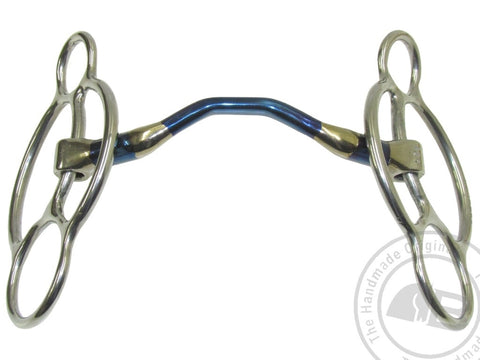SELECTING THE PERFECT BIT & BRIDLE
Bit fit
Horses mouths and palates are all different shapes and sizes, and one style definitely doesn't fit all. There is a huge amount of variation in the size, shape and where pressure is applied from bit-to-bit, impacting suitability for your horse.
As a general rule, the edges of the main arms of the bit (not including the rings) should fit snugly on either side of the horse's mouth. It is often said, there should be two creases in the skin on the edge of the horse's mouth.
The right bit shape and pressure can be a little more difficult to determine, and we recommend booking a professional bit fitting session where an experienced but fitter will look at the shape of your horse's mouth and palate and discuss any evasion issues with you that you might be trying to solve. Remember, that many evasion issues come from discomfort and spending the time and expense on getting bit fit right will not only ensure your horse is more comfortable, but will help to improve performance.
Many bit fitters such as Bit Bank allow trials on bits. When testing various bits, watch your horse closely:
- Does your horse look happy? Observe expressions, for example ears pinned back or lips snarled would indicate that the horse is in discomfort.
- Are they willing to take the contact? Feel the horses mouth and play with the contact to see if they feel 'light' in the mouth.
- Are they travelling in a relaxed frame? Observe your horses head carriage when you pick up the contact, if they are travelling with a stiff neck with their poll above their withers then this is an indication of tension and discomfort.
Dressage
Dressage or ‘stressage’ as some may say, is the art of mastering harmony and cadence with your horse, in a relaxed and supple manner. Whether this is your one and only discipline, or least favourite eventing phase, bit and bridle comfort is going to make all the difference in your horse's ability and willingness to accept the contact and work 'through' from the hind end into the bridle.
The most popular choice of dressage bit is arguably a snaffle. There are numerous types of snaffles currently available and FEI approved; Loose Ring Snaffle, Eggbutt, Full Cheek. If you're a more advanced dressage rider you will be using a double bridle, in which case you would be using a weymouth bit or 'bit and bradoon' which is a two-part bit, connected to the standard rein and curb rein of a double bridle.
In pairing a dressage bit with a dressage bridle, an important consideration is the noseband. Many riders opt for hanoverian nosebands (with flash strap under the chin) for horses that have a tendency to open their mouths or are evasive. Other riders argue the noseband is merely aesthetic and prefer unobtrusive cavesson nosebands. All double bridles come with cavesson nosebands so at higher level dressage, your horse must be able to work well in a cavesson.
Lumiere offers a number of 'convertible' bridles that can be worn as either a cavesson or a hanoverian due to a completely removeable flash strap. A popular convertible choice is the Anastasia, while some people swear by 'micklem style' bridles such as the Azure which are designed to avoid the sensitive nerve areas on the horse's head and keep the bit particularly stable.
 Pictured Above: Neue Schule Verbindend 9011, Neue Schule Turtle Top Eggbutt 7023E, Neue Schule Tranz Angled Full Cheek 8022FC
Pictured Above: Neue Schule Verbindend 9011, Neue Schule Turtle Top Eggbutt 7023E, Neue Schule Tranz Angled Full Cheek 8022FCShow jumping / hunter jumper
As any jumper knows, precise turns and stride control are critical and additional leverage and poll pressure can be required from a bit. A lot of jumping bits have various rings on them, allowing you to adjust pressure depending on what ring you attach your cheek strap or reins to. These types of bits can cause challenges for people with 'off the shelf' bridles, as a shorter cheek strap may be required when using the top rings of a jumping bit. Lumiere offers customisation of bridles to get the perfect fit, and it's not unusual for customers to buy a full bridle with pony cheek straps to accommodate jumping bits.
Nosebands are also a consideration for jumpers. Grackle or mexican noseband bridles such as the Ava are much-loved as a gentle support for horses who open their mouths or cross their jaw. The Lumiere Milan and Amour bridles are also popular choices and are convertible. And for the matchy addicts, the Amour has a matching breastplate (the Anka) and matching halter (the Bella) so you can have the whole set!
Take a look at Bit Banks top three show jumping bits to learn a bit more about the support these bits can provide in a harmonious jumping horse and rider:


Cross country



The perfect bridle
Ensuring correct bridle fit is critical. Most horse owners know the importance of getting saddle fit right, but not everyone pays the same amount of attention to bridle fit.
Horses have 12 sensitive cranial nerves on their head and face which control everything from balance to smell and sign. The bridle is positioned around very delicate areas of the horses face making it crucial to fit correctly and comfortably so that your horse is comfortable and able to perform at its best.
Horse's don't have cookie cutter sized faces which is why at Lumiere we offer the ability to customise bridles to get the perfect fit. All of our bridles are anatomically designed which means they feature gel-padding under headpieces and nosebands and have broad monocrown (single strap) head pieces with space for the ears that don't pinch, and distribute pressure evenly.
If you'd like help selecting the perfect bridle for your horse, our team would be happy to help! Email us at customer@lumiereequestrian.com


